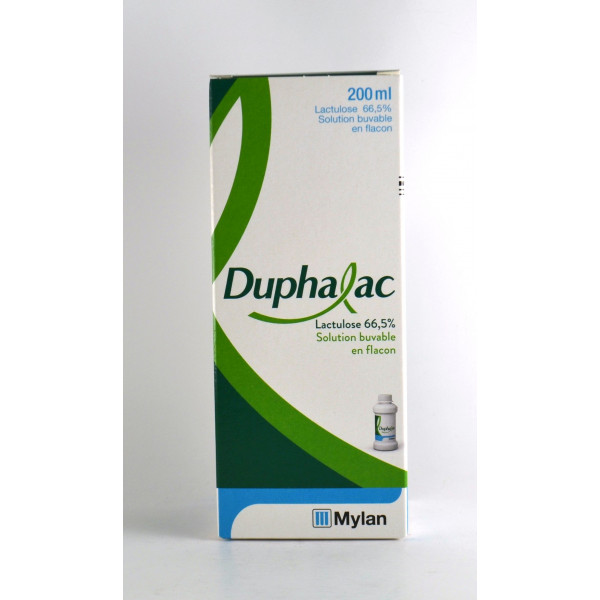1. NAME OF DRUG DUPHALAC 66.5%, drinkable solution. 2. QUALITATIVE AND QUANTITATIVE COMPOSITION Lactulose: 66.5 g Per 100ml of drinkable solution. To see a complete list of dilutants, see section 6.1. 3. PHARMACEUTICAL FORM Drinkable solution. 4. CLINICAL DATA 4.1. Therapeutic Indications - Symptomatic treatment for constipation. - Hepatic encephalopathy. 4.2. Dosage and how to use Orally. This medication can be taken in its pure state or diluted in a drink. Rectal. This medication put be dissolved in water. 15 ml of this medication = 10g of lactulose. Constipation The dosage must be adapted to each individual. The daily dose is: Newborns from 0-12 months: 1X5ml every day. Children 1-6 years old: 1X5ml or 1x10ml per day. Children 7-14 years old: - Attack treatment: 1X15ml per day. - Maintenance treatment: 1X10ml per day. Adults: - Attack treatment: 1-3 x 15ml per day. - Maintenance treatment: 1X10ml to 1x25ml per day. If you get diarrhoea, decrease the dosage. Hepatic encephalopathy The ideal dose is one that gives you two soft faeces per day. Treatment varies on the symptoms. - Treatment of attack by gastric tube or enema in case of coma or pre-coma: *Gastric tube: 90-150Ml or 3-5 30ml graduations pure or diluted in water. *Washing balloon tube: 300Ml or 10x10ml in one litre of warm water to keep for 20 minutes to an hour; can be repeated if needed 12 hours after. - Relay processing 15-30Ml or 1x15ml to 1x30ml, 3 times per day. 4.3. Contraindications - Over-sensitivity to lactulose or one of its dilutants. - Inflammatory organic colopathies (ulcerative colitis, Crohn's disease ...), occlusive or subocclusive syndrome, digestive perforation or suspicion of perforation, indeterminate abdominal pain syndromes. - Congenital galactosemia. 4.4. Special warnings and side effects Prolonged use of this medication is not recommended. 30 ml of solution has 116kj (28kcals) in and does affect diabetics. Treatment for constipation should also be combined with: - food rich in fibre and drinks, - physical activity and exoneration. In infants and children, the prescription of laxatives must be exceptional: it must take into account the risk of impairing the normal functioning of the exoneration reflex. Diarrhoea that can be induced by DUPHALAC can lead to disturbances of hydro-electrolyte balance; this medication should be used with caution in patients prone to hydro-electrolyte disorders (such as patients with impaired renal or hepatic function or receiving an associated diuretic). Due to the galactose content in this medication it is not suitable for those with congenital galactosemia, glucose/galactose malabsorption syndrome or sucrase-isomaltase insufficiency. Due to the lactose content in this medication it is not suitable for those with congenital galactosemia, glucose/galactose malabsorption syndrome or sucrase-isomaltase insufficiency. 4.5. Interactions with other drugs No study has been carried out. 4.6. Pregnancy and breast feeding Studies in animals have not shown a teratogen effect. In the absence of a teratogenic effect in animals, a malformative effect on the human species is not expected. To date the substances responsible for malformations in the human species have been shown to be teratogenic in animals during well-conducted studies on two species. In clinical studies there are no particular malformative or fetotoxic effects appeared to date. However monitoring pregnancies exposed to lactulose is not enough to rule out any risk. Given the data, the use of lactulose is not recommended during pregnancy unless necessary. 4.7. Effects on the ability to drive and operate machinery Not applicable. 4.8. Side effects - Bloating, semi-liquid faeces. These can appear at the beginning of treatment. They stop once treatment has been changed. - rare cases of pruritis, anal pain and weight loss. 4.9. Overdose Symptoms Diarrhoea and abdominal pain. Treatment Stop or reduce the dosage. Correction of possible hydroelectrolytic disorders in the event of significant fluid loss secondary to diarrhea and vomiting. 5. PHARMACOLOGICAL PROPERTIES 5.1. Pharmaco-dynamic properties OSMOTIC LAXATIVE. HYPO AMMONIA. Code ATC: A06AD11 (A: digestive and metabolism). 1. Lactulose increases hydration and the the volume of colic. 2. In the colon, the transformation of lactulose into organic acids lowers the pH of the colon content, thus reducing the absorption of ammonia. 5.2. Pharmacokinetics properties Lactulose, a synthetic disaccharide, passes through the upper parts of the digestive tract without modification and without resorption. In the colon, under the effect of the local saccharolytic flora, it is transformed into organic acids (lactic and acetic), which are eliminated in the stool. 5.3. Preclinical safety data Not applicable. 6. PHARMACEUTICAL DATA 6.1. List of dilutants Purified water. 6.2. Incompatibilities Not applicable. 6.3. Shelf life 3 years. 6.4. Storage precautions Keep in a place under 25°C. Do not put in the fridge. 6.5. Nature and contents of outside packaging 200 ml bottle with a polypropylene small pot. 6.6. Precautions for handling and disposal 7. THE MARKETING AUTHORISATION HOLDER ABBOTT PRODUCTS SAS 42, RUE ROUGET DE LISLE 92150 SURESNES 8. NUMBER OF THE MARKETING AUTHORSATION HOLDER · 352 351-4: 200 ml bottle with a polypropylene small pot. 9. START/RENEWEL DATE OF AUTHORISATION [To be completed by holder] 10. DATE OF UPDATE OF TEXT [To be completed by holder] 11. DOSIMETRY Not applicable. 12. INSTRUCTIONS FOR RADIOPHARMACEUTICAL PREPARATION Not applicable. PRESCRIPTION AND DELIVERY CONDITIONS Drug not subjected to prescription.



